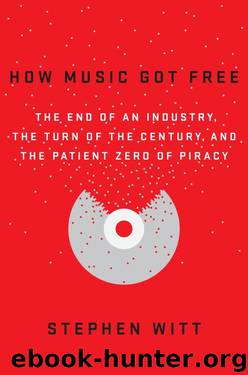How Music Got Free: The End of an Industry, the Turn of the Century, and the Patient Zero of Piracy by Stephen Witt

Author:Stephen Witt [Witt, Stephen]
Language: eng
Format: epub, mobi
Publisher: Penguin Publishing Group
Published: 2015-06-16T05:00:00+00:00
CHAPTER 13
By 2001 Brandenburg and Grill had parted ways. The compression ratios of the latest generation of psychoacoustic products were approaching theoretical limits, and the outstanding problems in the field were considered solved. The two sought other challenges. Grill, in Erlangen, went into satellite radio; Brandenburg, from his new lab in Ilmenau, into surround sound.
MPEG, too, was making progress. Video quality was improving, even as the files were shrinking. The upheaval in the music market soon spread to the movie market, as Scene crews that specialized in DVD ripping, in-theater camcorder bootlegs, and high-definition television emerged. Soon, movie files from the Scene were leaving the topsite networks and making their way into the wild.
The defenders of intellectual property were a step behind. The failed lawsuit against Diamond had shown that the technology itself could not be litigated against. Instead, media industries had to target the bad actors one at a time. Numerous lawsuits were filed against peer-to-peer operators, targeting companies like Grokster, LimeWire, and Kazaa. The upshot of these shifts was that the file-sharers no longer needed help compressing the files. They needed help distributing them.
Napster, though, was ruined, and the heirs to its shattered empire could match neither its quality nor its scope. Kazaa, eDonkey, LimeWire, BearShare, Gnutella, Grokster—the new peer-to-peer networks were frustrating morasses of crap. Requesting a song or movie on these networks meant joining a download queue behind hundreds of other users. Your wait time could run to hours, even days, and the entire time you waited in this line you were forced to advertise your computer’s IP address to the subpoena-crazed lawyers of Project Hubcap. Worse, when you did finally receive the file you’d requested, it often turned out to be a glitchy, low-fidelity encode, or a mistagged version of some other song entirely, or even a deliberate, earsplitting fake.
There was little incentive for the peer-to-peer entrepreneurs to invest in quality control. After the A&M Records vs. Napster decision they were plainly on the wrong side of the law, with no hope of buy-in from the media conglomerates. With their venture capital drying up, many operators in the peer-to-peer space began secretly bundling their supposedly “free” applications with gray-market adware, flooding the desktops of the unsuspecting with pitches for low-credit loan consolidations and penis-enlarging pharmaceuticals. Investors predictably rebelled, as did users, and for a time the file-sharing economy faced a return to the days of the pre-Napster IRC underground. But the underlying potential of peer-to-peer technology was still tremendous, and, even as mainstream capitalists abandoned it, the more idiosyncratic programming talent stuck around. And that was how an offbeat 25-year-old code warrior at a short-lived peer-to-peer start-up called MojoNation ended up using his spare time at a doomed job to rewrite the rules of Internet architecture.
His name was Bram Cohen, and he called his invention BitTorrent. Born in Manhattan, Cohen was a gifted programmer who competed in recreational mathematics tournaments in his spare time. He wore his hair long and his eyebrows thick, his voice
Download
How Music Got Free: The End of an Industry, the Turn of the Century, and the Patient Zero of Piracy by Stephen Witt.mobi
This site does not store any files on its server. We only index and link to content provided by other sites. Please contact the content providers to delete copyright contents if any and email us, we'll remove relevant links or contents immediately.
| Entertainment | Sports |
| Park & Recreation |
Life 3.0: Being Human in the Age of Artificial Intelligence by Tegmark Max(4508)
The Sports Rules Book by Human Kinetics(3588)
ACT Math For Dummies by Zegarelli Mark(3565)
The Age of Surveillance Capitalism by Shoshana Zuboff(3423)
Blood, Sweat, and Pixels by Jason Schreier(3130)
Unlabel: Selling You Without Selling Out by Marc Ecko(2981)
Urban Outlaw by Magnus Walker(2950)
Hidden Persuasion: 33 psychological influence techniques in advertising by Marc Andrews & Matthijs van Leeuwen & Rick van Baaren(2778)
The Pixar Touch by David A. Price(2740)
Bad Pharma by Ben Goldacre(2730)
Project Animal Farm: An Accidental Journey into the Secret World of Farming and the Truth About Our Food by Sonia Faruqi(2661)
Brotopia by Emily Chang(2592)
The Content Trap by Bharat Anand(2493)
Slugfest by Reed Tucker(2416)
The Airbnb Story by Leigh Gallagher(2371)
Kitchen confidential by Anthony Bourdain(2306)
Coffee for One by KJ Fallon(2008)
Smuggler's Cove: Exotic Cocktails, Rum, and the Cult of Tiki by Martin Cate & Rebecca Cate(1979)
Beer is proof God loves us by Charles W. Bamforth(1920)
